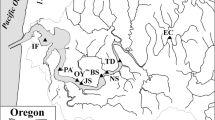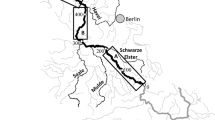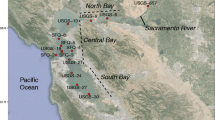Abstract
Denitrification rates along a salinity gradient in the eutrophic Neuse River Estuary, North Carolina, were quantified using membrane inlet mass spectrometry (MIMS) within short-term batch incubations. Denitrification rates within the system were highly variable, ranging from 0 to 275 μmol N m−2 h−1. Intrasite variability increased with salinity, but no significant differences were observed across the salinity gradient. Denitrification rates were positively correlated with sediment oxygen demand at the upstream sampling site where sediment organic carbon levels were lowest. This relationship was not observed in the more saline sampling sites. Denitrification rates were highest during winter. On an annual basis, denitrification accounted for 26% of the dissolved inorganic nitrogen and 12% of the total nitrogen supplied to the system.
Similar content being viewed by others
Literature Cited
An, S. andW. Gardner. 2002. Dissimilatory nitrate reduction to ammonium (DNRA) as a nitrogen link, versus denitrification as a sink in a shallow estuary (Laguma Madre/Baffin Bay, Texas).Marine Ecology Progress Series 237:41–50.
An, S., W. Gardner, andT. Kana. 2001. Simultaneous Measurement of Denitrification and Nitrogen Fixation Using Isotope Pairing with Membrane Inlet Mass Spectrometry Analysis.Applied and Environmental Microbiology 67:1171–1178.
An, S. andS. Joye. 2001. Enhancement of coupled nitrification-denitrification by benthic photosynthesis in shallow estuarine sediments.Limnology and Oceanography 46:62–74.
Barnes, J. andN. J. P. Owens. 1998. Denitrification and nitrous oxide concentrations in the Humber Estuary, United Kingdom, and adjacent coastal zones.Marine Pollution Bulletin 37:247–260.
Boesch, D. F. 2002. Challenges and opportunities for science in reducing nutrient over-enrichment of coastal ecosystems.Estuaries 25:886–900.
Boesch, D., R. Brinsfield, andR. Magnien. 2001. Chesapeake Bay Eutrophication: Scientific Understanding, Ecosystem Restoration, and Challenges for Agriculture.Journal of Environmental Quality 30:303–320.
Boyer, J., R. Christian, andD. Stanley. 1993. Patterns of phytoplankton primary productivity in the Neuse River Estuary, North Carolina, USA.Marine Ecology Progress Series 97:287–297.
Boyer, J., D. Stanley, andR. Christian. 1994. Dynamics of NH4+ and NO3− uptake in the water column of the Neuse River Estuary, North Carolina.Estuaries 17:361–371.
Brostrom, G. andJ. Nilsson. 1999. A theoretical investigation of the diffusive boundary layer in benthic flux chamber experiments.Journal of Sea Research 42:179–189.
Buzzelli, C. P., R. A. Luettich, Jr,S. P. Powers, C. H. Peterson, J. E. McNinch, J. L. Pinckney, andH. W. Paerl. 2002. Estimating the spatial extent of bottom-water hypoxia and habitat degradation in a shallow estuary.Marine Ecology Progress Series 230:103–112.
Christian, R., J. Boyer, andD. Stanley. 1991. Multi-year distribution patterns of nutrients within the Neuse River Estuary, North Carolina.Marine Ecology Progress Series 71:259–274.
Christian, R. R., W. Bryant, and D. W. Stanley. 1986. The relationship between river flow andMicrocystis aeruginosa blooms in the Neuse River, North Carolina. Water Resources Research Institute of the University of North Carolina Report. Report Number 223. Raleigh, North Carolina.
Christian, R. R., W. M. Rizzo, and D. W. Stanley. 1989. Influence of nutrient loading on the Neuse River Estuary, North Carolina. National Undersea Research Program, National Oceanic and Atmospheric Administration. Research Report No. 89-2. Washington, D.C.
Clesceri, Erika, J. 2003. Quantification of particulate organic matter sources in an eutrophic river estuary by stable carbon and nitrogen isotopes and photopigments (Neuse River Estuary, NC, USA). Ph.D. Dissertation, University of North Carolina at Chapel Hill, Chapel Hill, North Carolina.
Colt, J. 1984. Computation of dissolved gas in water as functions of temperature, salimity, and pressure.American Fisheries Society 14:1–154.
Conley, D. J. 2000. Biogeochemical nutrient cycles and nutrient management strateties.Hydrobiologia 410:87–96.
Cornwell, J., W. M. Kemp, andT. Kana. 1999. Denitrification in coastal ecosystems: Methods, environmental controls, and ecosystem level controls, a review.Aquatic Ecology 33:41–54.
Cowan, J. andW. Boynton. 1996. Sediment-water oxygen and nutrient exchanges along the longitudinal axis of Chesapeake Bay: Seasonal patterns, controlling factors and ecological significance.Estuaries 19:562–580.
Cowan, J., J. Pennock, andW. Boynton. 1996. Seasonal and interannual patterns of sediment-water nutrient and oxygen fluxes in Mobile Bay, Alabama (USA): Regulating factors and ecological significance.Marine Ecology Progress Series 141:229–245.
Desimone, L. A. andB. L. Howes. 1996. Denitrification and nitrogen transport in a coastal aquifer receiving wastewater discharge.Environmental Science and Technology 30:1152–1162.
Devol, A. 1991. Direct measurement of nitrogen gas fluxes from continental shelf sediments.Nature 349:319–320.
Devol, A. H. andJ. P. Christensen. 1993. Benthic fluxes and nitrogen cycling in sediments of the continental margin of the eastern North Pacific.Journal of Marine Research 51:345–372.
Eyre, B. D. andA. J. P. Ferguson. 2002. Comparison of carbon production and decomposition, benthic nutrient fluxes and denitrification in seagrass, phytoplankton, benthic microalgaeand macroalgae-dominated warm-temperate Australian lagoons.Marine Ecology Progress Series 229:43–59.
Eyre, B., S. Rysgaard, T. Dalsgaard, andP. B. Christensen. 2002. Comparison of isotope pairing and N2:Ar methods for measuring sediment denitrification—Assumptions, modifications, and implications.Estuaries 25:1077–1087.
Eyre, B., S. Rysgaard, T. Dalsgaard, andP. B. Christensen. 2004. Reply to comment on our paper “Comparison of isotope pairing and N2:Ar methods for measuring sediment denitrification”.Estuaries 27:177–178.
Fear, J. 2003. The influence of sediment oxygen demand and denitrification on nitrogen cycling in the eutrophic Neuse River Estuary, North Carolina, USA. Ph.D. Dissertation, University of North Carolina at Chapel Hill, Chapel Hill, North Carolina.
Fisher, T. R., P. R. Carlson, andR. T. Barber. 1982. Sediment nutrient regeneration in three North Carolina estuaries.Estuarine Coastal and Shelf Science 14:101–116.
Fisher, T. R., A. B. Gustafson, K. Sellner, R. Lacouture, L. W. Haas, R. L. Wetzel, R. Magnien, D. Everitt, B. Michaels, andR. Karrh. 1999. Spatial and temporal variation of resource limitation in Chesapeake Bay.Marine Biology 133:763–778.
Fleming, J. 2003. The hydrodynamics of the upper Neuse River Estuary, North Carolina and their influence on dissolved oxygen distribution. Ph.D. Dissertation, University of North Carolina at Chapel Hill, Chapel Hill, North Carolina.
Giblin, A., C. Hopkinson, andJ. Tucker. 1997. Benthic metabolism and nutrient cycling in Boston Harbor, Massachusetts.Estuaries 20:346–364.
Giese, G. L., H. B. Wilder, and G. G. Parker, Jr. 1979. Hydrology of major estuaries and sounds of North Carolina. U.S. Geological Survey, Water-Resources Investigation. Report number 79-46, Raleigh, North Carolina.
Glud, R. N., S. Forster, andM. Huettel. 1996. Influence of radial pressure gradients on solute exchange in stirred benthic chambers.Marine Ecology Progress Series 141:303–311.
Hall, P., L. Anderson, M. R. van der Loeff, B. Sundby, andS. Westerlund. 1989. Oxygen uptake kinetics in the benthic boundary layer.Limnology and Oceanography 34:734–746.
Hansen, J. I., K. Henriksen, andT. H. Blackburn. 1981. Seasonal distribution of nitrifying bacteria and rates of nitrification in coastal marine sediments.Microbial Ecology 10:25–36.
Herbert, R. A. 1999. Nitrogen cycling in coastal marine ecosystems.FEMS Microbiology Review 23:563–590.
Hopkinson, Jr.,C. S., A. E. Giblin, J. Tucker, andR. H. Garritt. 1999. Benthic metabolism and nutrient cycling along an estuarine salinity gradient.Estuaries 22:863–881.
Hynes, R. K. andR. Knowles. 1984. Production of nitrous oxide byNitrosomonas europaea: Effects of acetylene, pH, and oxygen.Canadian Journal of Microbiology 30:1397–1404.
Jenkins, M. andM. W. Kemp. 1984. The coupling of nitrification and denitrification in two estuarine sediments.Limnology and Oceanography 29:609–619.
Jensen, K., M. Jensen, andR. Cox. 1996. Membrane inlet mass spectrometric analysis of N-isotope labeling for aquatic denitrification studies.FEMS Microbiology Ecology 20:101–109.
Kana, T. 1998. Denitrification in estuarine sediments determined by membrane inlet mass spectrometry.Limnology and Oceanography 43:334–339.
Kana, T., C. Darkangelo, D. Hunt, J. Oldham, G. Bennet, andJ. Cornwell. 1994. Membrane inlet mass spectrometer for rapid high-precision determination of N2, O2, and Ar in environmental water samples.Analytical Chemistry 66:4166–4170.
Kana, T. andD. L. Weiss. 2004. Comment on “Comparison of isotope pairing and N2:Ar methods for measuring sediment denitrification” by B. D. Eyre, S. Rysgaard, T. Dalsgaard, and P. B. Christensen. 2002. Estuaries 25:1077–1087.Estuaries 27:173–176.
Kemp, W. M., P. Sampou, J. Caffrey, M. Mayer, K. Henriksen, andW. R. Boynton. 1990. Ammonium recycling versus denitrification in Chesapeake Bay sediments.Limnology and Oceanography 35:1545–1563.
Laursen, A. E. andS. P. Seitzinger. 2002. The role of denitrification in nitrogen removal and carbon mineralization in Mid-Atlantic Bight sediments.Continental Shelf Research 22:1397–1416.
Lebo, M. 1995. Sediment oxygen demand (SOD) along the Neuse River. Weyerhaeuser: Southern Environmental Field Station: Technical Report: Project Number 722-9527:1–33. New Bern, North Carolina.
Lebo, M., D. G. McHenry, and J. Fromm. 2001. Neuse River Estuary modeling and monitoring project stage 1: Evaluating historical nutrient and chlorophyll patterns in the Neuse River Basin. Water Resources Research Institute of the University of North Carolina Report. Report Number 325-H. Raleigh, North Carolina.
Luettich, Jr., R., J. McNinch, H. Paerl, C. Peterson, J. Wells, M. Alperin, C. Martens, and J. Pinckney. 2000. Neuse River Estuary modeling and monitoring project stage 1: Hydrography and circulation, water column nutrients and productivity, sedimentary processes and benthic-pelagic coupling, and benthic ecology. Water Resources Research Institute of the University of North Carolina Report. Report Number 325-B. Raleigh, North Carolina.
Matson, E. andM. Brinson. 1990. Stable carbon isotopes and the C:N ratio in the estuaries of the Pamlico and Neuse Rivers, North Carolina.Limnology and Oceanography 35:1290–1300.
Nixon, S. W. 1995. Coastal marine eutrophication: A definition, social causes, and future concerns.Ophelia 41:199–219.
Nixon, S., J. W. Ammerman, L. P. Atkinson, V. M. Berounsky, G. Billen, W. C. Boicourt, W. R. Boynton, T. M. church, S. M. Ditoro, R. Elmgren, J. H. Garber, A. E. Giblin, R. A. Jahnke. N. J. P. Owens, M. E. Q. Pilson, and S. P. Seitzinger. 1996. The fate of nitrogen and phosphorus at the land-sea margin of the North Atlantic Ocean.Biogeochemistry 35:141–180.
Nowicki, B. 1994. The effect of temperature, oxygen, salinity and nutrient enrichment on estuarine denitrification rates measured with a modified nitrogen gas flux technique.Estuarine, Coastal and Shelf Science 38:137–156.
Nowicki, B. L., E. Requintina, D. van Keuren, andJ. R. Kelly. 1997. Nitrogen losses through sediment denitrification in Boston Harbor and Massachusetts Bay.Estuaries 20:626–639.
Paerl, H. W. 1995. Coastal eutrophication in relation to atmospheric nitrogen deposition: Current perspectives.Ophelia 41:237–259.
Paerl, H. W., J. D. Bales, L. W. Ausley, C. P. Buzzelli, L. B. Crowder, L. A. Eby, M. Go, B. Peierls, T. L. Richardson, andJ. S. Ramus. 2000. Hurricanes’ hydrological, ecological effects linger in major U.S. estuary.EOS, Transactions, American Geophysical Union 81:457, 459–462.
Paerl, H., J. Bales, L. Ausley, C. Buzzelli, L. Crowder, L. Eby, J. Fear, M. Go, B. Peierls, T. Richardson, andJ. Ramus. 2001. Ecosystem impacts of three sequential hurricanes (Dennis, Floyd, and Irene) on the United States’ largest lagoonal estuary, Pamlico Sound, North Carolina.Proceedings of the National Academy of Sciences 98:5655–5660.
Paerl, H., J. Pinckney, J. Fear, andB. Peierls. 1998. Ecosystem responses to internal and watershed organic matter loading: Consequences for hypoxia in the eutrophying Neuse River Estuary, North Carolina, USA.Marine Ecology Progress Series 166:17–25.
Pattinson, S. N., R. Garcia-Ruiz, andB. A. Whitton. 1998. Spatial and seasonal variation in denitrification in the Swale-Ouse system, a river continuum.The Science of the Total Environment 210/211:289–305.
Peierls, B. L., R. R. Christian, andH. W. Paerl. 2003. Water quality and phytoplankton as indicators of hurricane impacts on a large estuarine ecosystem.Estuaries 26:1329–1343.
Piehler, M., S. Thompson, J. Dyble, P. Moisander, J. Fear, and H. Paerl. 2002. Biologically mediated nitrogen dynamics in eutrophying estuaries. Assessing denitrification, N2 fixation and primary productivity responses to proposed N loading reductions in the Neuse River Estuary. Water Resources Research Institute of the University of North Carolina Report. Report Number 339. Raleigh, North Carolina.
Pinckney, J., D. Millie, B. Vinyard, andH. Paerl. 1997. Environmental controls of phytoplankton bloom dynamics in the Neuse River Estuary, North Carolina, U.S.A.Canadian Journal of fish and Aquatic Sciences 54:2491–2501.
Pinckney, J., H. W. Paerl, M. B. Harrington, andK. E. Howe. 1998. Annual cycles of phytoplankton community-structure and bloom dynamics in the Neuse River Estuary, North Carolina.Marine Biology 131:371–381.
Rabalais, N. N., E. Turner, Q. Dortch, D. Justic, V. J. Bierman, Jr., andW. J. Wiseman, Jr. 2002. Nutrient-enhanced productivity in the northern Gulf of Mexico: Past, present, and future.Hydrobiologia 475/476:39–63.
Rizzo, W. andR. Christian. 1996. Significance of subtidal sediments to heterotrophically-mediated oxygen and nutrient dynamics in a temperate estuary.Estuaries 19:475–487.
Rudek, J., H. Paerl, M. Mallin, andP. Bates. 1991. Seasonal and hydrological control of phytoplankton nutrient limitation in the lower Neuse River Estuary, North Carolina.Marine Ecology Progress Series 75:133–142.
Rysgaard, S., P. B. Christensen, andL. P. Nielsen. 1995. Seasonal variation in nitrification and denitrification in estuarine sediment colonized by benthic microalgae and bioturbating infauma.Marine Ecology Progress Series 126:111–121.
Rysgaard, S., P. Thastum, T. Dalsgaard, P. B. Christensen, andN. P. Sloth. 1999. Effects of salinity on NH4+ adsorption capacity, nitrification, and denitrification in Danish estuarine sediments.Estuaries 22:21–30.
Santschi, P., R. Anderson, M. Fleisher, andW. Bowles. 1991. Measurements of diffusive sublayer thicknesses in the ocean by alabaster dissolution, and their implications for measurements of benthic fluxes.Journal of Geophysical Research 96:10641–10657.
Sauber, J. and H. Quidley. 1998. Neuse River Internal Nutrient Loading Studies 1996–1997.North Carolina—Division of Water Quality Technical Report: 1–53.
Seitzinger, S. P. 1988. Denitrification in freshwater and coastal marine ecosystems: Ecological and geochemical significance.Limnology and Oceanography 33:702–724.
Seitzinger, S. P., W. S. Gardner, andA. K. Spratt. 1991. The effect of salinity on ammonium sorption in aquatic sediments: Implications for benthic nutrient recycling.Estuaries 14:167–174.
Seitzinger, S., S. Nixon, andM. E. Q. Pilson. 1984. Denitrification and nitrous oxide production in a coastal marine ecosystem.Limnology and Oceanography 29:73–83.
Sloth, N., H. Blackburn, L. S. Hansen, N. Risgaard-Petersen, andB. A. Lomstein. 1995. Nitrogen cycling in sediments wity different organic loading.Marine Ecology Progress Series 116:163–170.
Smith, C. J., R. D. Delaune, andW. H. Patrick, Jr. 1985. Fate of riverine nitrate entering an estuary: I. Denitrification and nitrogen burial.Estuaries 8:15–21.
Steinberger, N. andM. Hondzo. 1999. Diffusional mass transfer at sediment-water interface.Journal of Environmental Engineering 125:192–200.
Vitousek, P. M. 1994. Beyond global warming: Ecology and global change.Ecology 75:1861–1876.
Vitousek, P. M. andR. W. Howarth. 1991. Nitrogen limitation on land and in the sea: How can it occur?.Biogeochemistry 13:87–115.
Yoon, W. B. andR. Benner. 1992. Denitrification and oxygen consumption in sediments of two south Texas estuaries.Marine Ecology Progress Series 90:157–167.
Zimmerman, A. R. andR. Benner. 1994. Denitrification, nutrient regeneration and carbon mineralization in sediments of Galveston Bay, Texas, USA.Marine Ecology Progress Series 114:275–288.
Source of Unpublished Materials
Alperin, M. J. personal communication. Department of Marine Sciences, 17-4 Venable Hall, CB 3300, The University of North Carolina at Chapel Hill, Chapel Hill, North Carolina 27599-3300.
Author information
Authors and Affiliations
Corresponding author
Rights and permissions
About this article
Cite this article
Fear, J.M., Thompson, S.P., Gallo, T.E. et al. Denitrification rates measured along a salinity gradient in the eutrophic Neuse River estuary, North Carolina, USA. Estuaries 28, 608–619 (2005). https://doi.org/10.1007/BF02696071
Received:
Revised:
Accepted:
Issue Date:
DOI: https://doi.org/10.1007/BF02696071




